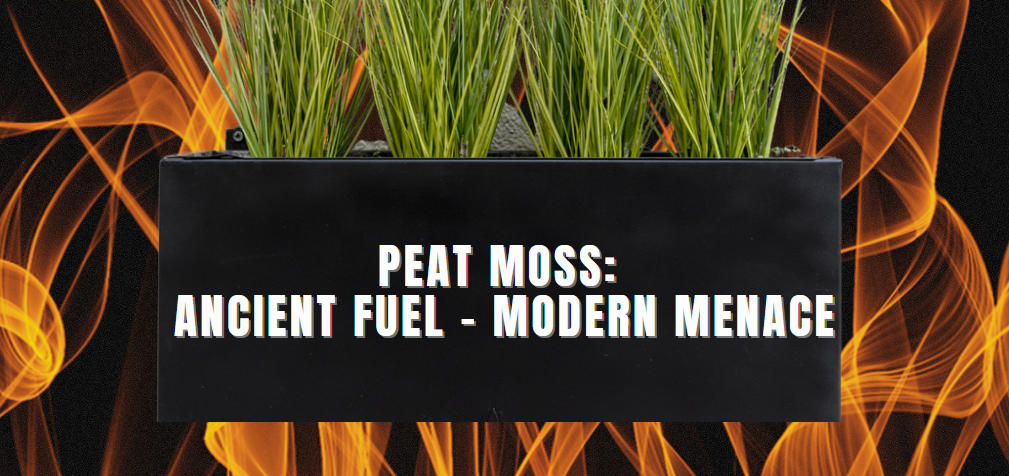
5 minute read
from Insite to Condos Fall 2023
by C C I
In the lush hills of Northern Ireland, a young lad named Ciaran, a seasoned sheep farmer, found himself chilled one morning. His dimming fireplace barely keeping his fingers from freezing, when he set out to the peatlands. Passing his sheep, memories of times with his father, the shared tradition and art of cutting peat warmed his spirit. With a day's labor, he collected enough peat for a week’s warmth. As the cozy scent filled his cottage, he felt profoundly connected to his ancestors, their tales and the land
Would that it were so simple.
Such a connection to peat isn't unique to Ciaran. Archaeological findings indicate that peat moss was utilized as fuel by Iron Age farmers in parts of Belgium and the Netherlands as far back as 725BC. It still powers electrical plants in Europe and is so prevalent in North America that we often trample all over it while hiking without ever giving it a second thought This fuel, with energy equivalent to most woods and when treated - even coal - frequently appears as a primary ingredient in potting soils.
Spring often ushers in the excitement of gardening. Residents and gardening committees alike embark on beautifying community spaces and balconies. Yet, as summer advances, enthusiasm wanes. Plants are forgotten, soil dries, and greenery turns to tinder. Planters go unattended, while smokers, often observed but needs ignored, find a resting place for their discarded butts in these very planters.
How potent is peat moss as fuel? A 12-inch round, 12-inch deep pot of soil, primarily composed of peat moss, can emit an astounding 94,000 BTUs if ignited. That’s about 800 BTUs per square inch. For reference, a good Barbeque puts out 80 to 100 BTUs per square inch.
Condo life often brings with it the sight of neglected planters Add a lack of designated smoking areas and ashtrays, which is just as common as neglected planters - and the stage is set for disaster. A casually discarded cigarette butt can smolder in a planter for hours, even days. Additives in the soil, like vermiculite, insulate the smoldering butts – giving them every possible chance to heat up - while other additives, like polystyrene, act as fuel accelerants increasing the temperatures once ignited Under the right conditions, this can lead to a devastating fire that spreads quickly.
Each year in Canada, cigarette-induced fires account for around $50 million in economic losses The gravity of the situation will only intensify with the rise in hotter and drier conditions. In 2018, an apartment complex in Edmonton faced $14 million in damages from such a fire. While residents escaped, and losses were officially covered cherished possessions were destroyed.
Safety professionals in the media repeat the usual refrain and underscore the necessity of proper cigarette disposal. Condo communities should have designated smoking areas with proper ashtrays provided, even signage to encourage good and safe habits. As we face rising temperatures, it's essential for condominium communities to think carefully, proactively address the risk, and communicate the hazards of carelessly discarded cigarettes in planters to their communities in a thoughtful manner.
A pot of soil, primarily composed of peat moss, can emit an astounding 94,000 BTUs
Peat moss, while traditionally lauded for its water retention and aeration properties in potting soil, is increasingly under scrutiny for its environmental impact. Harvesting peat moss involves draining and excavating peat bogs, a process which releases significant amounts of stored carbon into the atmosphere, exacerbating greenhouse gas emissions and global warming Furthermore, these bogs, when left undisturbed, are vital ecosystems that support unique biodiversity and act as essential carbon sinks Fortunately, consumers today have a plethora of eco-friendly alternatives to choose from, such as coconut coir, composted pine bark, and vermiculite. By making informed decisions and opting for these sustainable choices, individuals can play a pivotal role in reducing their carbon footprint and promoting environmental stewardship. The best way to avoid accidental fires is to remove this potent fuel from your property completely and opt for safer and more sustainable alternatives.
Further mitigation strategies:
Cater to resident behaviors: designate smoking areas and provide appropriate, commercial grade receptacles Show the community how important this problem is by buying proper ashtrays
Install signage to encourage direct proper disposal of butts
Communicate the risk to residents. Use yearly fire inspections as an opportunity so that new owners are always made aware.
Send out notices during heat waves to all owners about the dangers of potting soil and cigarette butts.
Set clear roles for groundskeeping, especially during heatwaves. Keep soil moist during hot spells, even the empty pots.
Equip gardening committees and maintenance staff with the necessary tools to keep soil moist
Use fire-resistant clay pots where possible
Place decorative planters away from flammable surfaces
Store unused potting soil and planters safely offseason.
Trim away dead branches, and plants - maintain plants and trees regularly.
Always ensure complete extinguishment of cigarettes.
Update your bylaws and rules as necessary to help tackle this issue.
Remind residents that the City of Edmonton bylaws allow for fines of $250 for smoking improperly on city property and another $250 for littering. Call 311 for help.
Encourage the entire community to report improperly discarding butts
Make sure everyone knows what to do if there is a fire! Distribute a fire plan to all owners
The potential severity of an event, no matter how rare, merits preventative steps.



